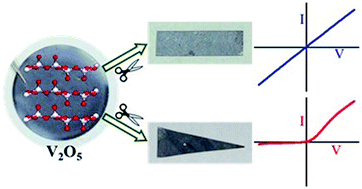A two-dimensional ion-pump of a vanadium pentoxide nanofluidic membrane†
Abstract
The reactive surface and layered crystal structure of vanadium pentoxide (V2O5) are exploited here to prepare a two-dimensional (2D) ion pump that transports ions against their concentration gradient. The exfoliated layers of V2O5 were assembled into membrane form to create ion-channels with excellent nanofluidic transport characteristics. At the surface-charge-governed regime, the flexible and freestanding membrane of V2O5 showed a remarkable proton conductivity (∼0.01 S cm−1). The activation energy of proton conductivity (0.066 eV) suggests that the exceptional mobility of H+ ions (5.2 × 10−3 cm2 V−1 s−1) inside V2O5 ion-channels originates from the coordinated hopping of charges between the two-dimensionally arranged water molecules. The transport characteristics of V2O5 ion-channels can also be tuned just by tailor-cutting its lamellar membranes into different shapes. While rectangular devices of V2O5 membranes exhibit linear I–V curves, the triangularly cut membranes display a diode-like non-linear I–V curve. The ionic current rectification in the V2O5 triangle was found to originate from a combination of the unipolar conductivity of counter-ions inside the 2D nanochannels and geometrical asymmetry. The 2D ion rectifier of V2O5 also pumps ions at the rate of 3.32 × 10−8 amp s−1 against a 1000-fold concentration gradient under a fluctuating external potential with zero mean.



 Please wait while we load your content...
Please wait while we load your content...